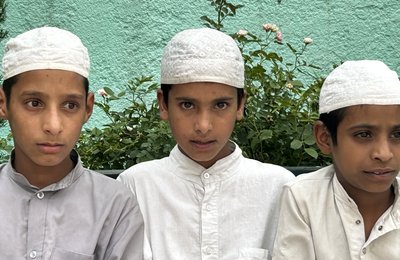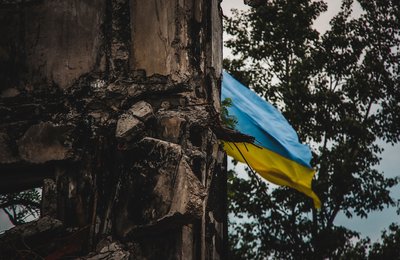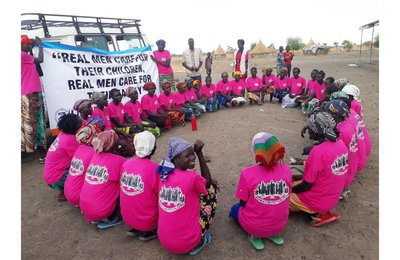I can still feel the heat of the Ghanaian sun on my face as I said goodbye to the Liberian refugees I had been working with in the Buduburam refugee settlement. The tears that fell were not entirely full of sadness, but hope and resolve. I would pursue the knowledge needed to help bring peace to individuals and communities who have suffered violent conflict. I would learn how to rehabilitate those who had lost their sense of security and structure from violence.
In Buduburam, I had seen the importance of dialogue in the peacebuilding process; how to bring elders, religious and tribal leaders together after years of division. I saw how a small peace programme could provide invaluable information to, and support for, national refugee agencies, Truth and Reconciliation Commissions and UN bodies. However, I also realised I had just scratched the surface of peacebuilding. How far do these peace programmes reach? If these programmes were supported on a large scale, what would be the impact? Would people continue to use these skills after they repatriated or were resettled?After five years of study and research, I am able to answer some of my questions. We must keep hope that the international development community learns the value of supporting peace programmes in order to help individuals, communities and nations break the cycles of violence.
Peace programmes focus on conflict resolution techniques, empowerment, nonviolence, cooperation, moral sensitivity, self-esteem, social rehabilitation and critical thinking. These programmes carry the optimism that people can learn the tools necessary to mitigate conflict and create cultures of peace. It is hoped that societal healing will begin within the camp and spread to an individual‘s country of origin upon returning home.
With more than half of conflicts relapsing back into war within ten years of peace agreements being signed, it is important to gain insights into conflict containment structures and the capacities required for post-conflict environments in order to prevent violence from recurring. However, I found there is little published on the effects of peace programmes and no research was found on refugee peace programme participants using their skills in post-conflict communities upon repatriation. My research attempted to address this gap through establishing whether the implementation of refugee camp peace programmes can contribute to post-conflict peacebuilding strategies once peace programme participants repatriate.
 Rwandese deportation in Nakivale.
Rwandese deportation in Nakivale.My research goal was to allow for the emergence of explanatory models which can assist refugee aid delivery, repatriation operations and post-conflict peacebuilding initiatives. Research took place in the Nakivale Refugee Settlement in Uganda and in post-conflict Liberia. The study contrasts perspectives and experiences of refugees, returnees, camp service providers and organisations to determine how peace programmes can contribute or have contributed to sustainable peacebuilding strategies in post-conflict communities.
Four key themes pertaining to how refugee peace programmes contribute to sustainable peacebuilding strategies were identified:
(1) Alleviation of Trauma – The participants’ stated peace programmes increase community co-existence through the promotion of psychosocial well-being in the form of trauma healing.
(2) Supporting Development – Skills obtained from peace programmes were said to not only support new development initiatives, but also believed to support and sustain existing development activities, especially protection and rule of law structures.
(3) Assists Reintegration – By strengthening conflict resolution and mediation skills, bottom-up approaches to peacebuilding are developed through community-centered intervention.
(4) Promotion of Self-Reliance – Participants learn to resolve conflicts for themselves, which in turn fosters self-reliant behaviour and the desire to be a community leader, which subsequently leads these individuals to form peace groups. Peace groups inspire the formation of dedicated groups that work on livelihoods issues. Both forms of groups, peace and livelihood, support the development of institutions from the grassroots level, thereby providing an ideal foundation for the development of civil society groups.
The data highlighted three overarching themes which directly prevented refugee camp peace programmes contribution to sustainable peacebuilding strategies in post-conflict communities:
 Peacebuilding and Conflict Resolution Certificate programme
Peacebuilding and Conflict Resolution Certificate programme(1) Programme Identification and Design – Programming is influenced by host governments and individual interests of service provider organisations, or employees weakening programme identification exercises targeting the recipients of aid. In addition, there is a direct disconnect in acknowledging future realities, and embedded conditions obscure accurate assessments of what is needed by the recipients themselves.
(2) Implementation Standards – The participants revealed that without long-term implementation plans, capacity building support, and donor investment, the impact of refugee camp peace programmes in post-conflict environments will remain deficient and unable to reach their full potential.
(3) Measuring Impact – The participants voiced their desire to create a positive impact in post-conflict communities, however if the stringent adherence to benchmarks for measuring impacts are not eased, refugee camp peace programmes will fail to be recognised as an effective post-conflict peacebuilding strategy.
Whilst my research was based on refugee peace programmes, it reveals the value of peace programmes for all communities. Not only can these programmes rebuild social trust and a sense of community, they can address issues of discrimination and intolerance whilst nurturing respect for human rights and gender equality. They encourage pro-social values and support norms of non-violence and law. Fostering social empowerment peace programmes encourages leadership, which in turn assists in mobilising community groups, thereby building healthy civil society initiatives and community‘s working towards their economic well-being.
My concern is that the world will continue to play a reactive role when dealing with violence unless all countries, including peaceful countries, work towards developing an infrastructure of peace. Under traditional aid programming policy, the priority of physical needs over psychosocial needs perpetuates aid dependency and ignores the importance of individual transformation. Peace programmes should be considered a foundational development programme implemented alongside health, education, water, and food programmes.
Unfortunately, peace programming is not common policy or strongly invested in. Untold amounts of money are spent on war, and yet when asking donors to fund peace programmes, it is often believed unnecessary in comparison to economic stability, security or infrastructure. It follows that many believe peace cannot be attained unless the latter are achieved first. However, I have found that peace programming is considered an essential piece of the puzzle, and when ignored, creates a perpetual cycle of violence. In this sense, true security, economic stability, and infrastructure development will never be sustainable.
After years of research, discussing and reflecting on issues surrounding human insecurity and conflict, my thoughts and feelings have cycled through hope and despair; cynicism, realism and optimism. At this point in history, I wonder why we cannot rise to the challenge and bridge individual healing with wider community structures for peace? Could it be possible to reduce conflict if we actually made peace programmes an equal priority alongside post-conflict reconstruction and sustainable development initiatives? In a world where we design early warning systems to prevent loss of life and infrastructure due to natural disasters, why can we not work towards developing a similar system for conflict?
I would like to thank those individuals that participated in my study, and hope their voices are honoured through continued discussions and deliberate action. It is time to invest in peace programmes and make peace an action word.
The full study can be reviewed here: What happens after the war? How refugee camp peace programmes contribute to post-conflict peacebuilding strategies.
This article was also published on the Local First blog. Local First is an approach to international development that prioritises the views and leadership of people and organisations in the countries affected, over those of outsiders from the international community.










